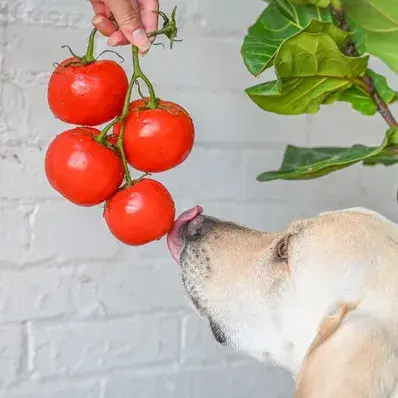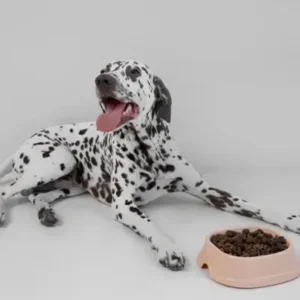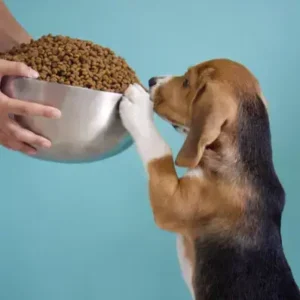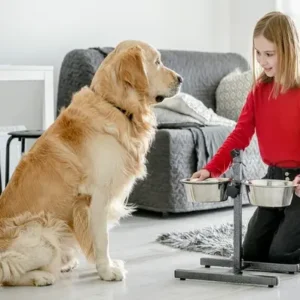Are Tomatoes Good for Dogs?
Tomatoes, in moderation can offer health benefits for your dog breed. They contain antioxidants, fiber, and vitamins that can help support your dog’s overall health. For example,
- Vitamin A in tomatoes supports eye health,
- Vitamin C boosts the immune system.
Tomatoes are also low in calories, making them a good occasional snack if you’re watching your dog’s weight.
You might also be wondering, can dogs eat tomatoes and lettuce together? Yes, this combination can be a healthy treat for your dog. Both vegetables provide low-calorie fiber, which can aid digestion.
Risks of Feeding Dogs Tomatoes
While ripe tomatoes can be healthy for dogs, they come with certain risks. The tomato plant contains solanine, a naturally occurring toxin, particularly in the stems, leaves, and unripe tomatoes. If a dog eats large amounts of these parts, they may experience symptoms like:
- Vomiting
- Diarrhea
- Lethargy
- Abdominal pain
- Loss of coordination
- Loss of appetite
- Muscle weakness
- Hypersalivation
- Tremors
- Lethargy
- Dilated pupils
If you notice any of these symptoms, your dog might have tomato poisoning. Call your vet immediately and let them know what your dog ate and how much. If you can, take a sample of the tomato or plant to help with the diagnosis. Acting quickly can help your dog recover faster.
In the meantime:
- Do not try to induce vomiting unless instructed by your vet.
- Keep your dog calm and hydrated.
- Monitor their symptoms closely, noting any changes in behavior or physical condition.
Early intervention is key to managing tomato poisoning, so don’t hesitate to seek professional advice if you’re concerned.
How Much Tomato Can Dogs Eat Safely?
Dogs can safely eat ripe tomatoes in moderation. As with any treat, it’s important to follow the 10% rule: treats (including tomatoes) should make up no more than 10% of your dog’s daily caloric intake. The rest of their diet should consist of well-balanced dog food.
While ripe tomatoes are generally safe for dogs, they should be fed in small amounts, especially if your dog has never eaten tomatoes before. Introducing new foods gradually helps prevent digestive issues. Always avoid feeding your dog unripe tomatoes or the green parts of the plant, as these can be toxic to dogs.
Tomato Portion Sizes by Dog Size
Here’s a breakdown of how many tomatoes different-sized dogs can safely eat:
| Dog Size | Tomato Portion | Examples |
| Extra-small (2–20 lbs) | Up to two ½-inch cubes of tomato | Chihuahua, Yorkshire Terrier, Pomeranian |
| Small (21–30 lbs) | Up to three ½-inch cubes of tomato | Cavalier King Charles Spaniel, Shiba Inu, Cocker Spaniel, Cockapoo |
| Medium (31–50 lbs) | Up to four ½-inch cubes of tomato | Border Collie, Australian Shepherd, Bulldog |
| Large (51–90 lbs) | Four or five ½-inch cubes of tomato | German Shepherd, Boxer, Dalmatian |
| Extra-large (91+ lbs) | Five or six ½-inch cubes of tomato | Saint Bernard, Tibetan Mastiff, Newfoundland |
When to Avoid Tomatoes for Dogs?
Not all dogs should eat tomatoes. Avoid feeding tomatoes to dogs that have the following conditions:
- Gastrointestinal issues: If your dog has a sensitive stomach, tomatoes might cause digestive upset.
- Sensitivity to solanine: Some dogs might be more sensitive to solanine, so it’s best to err on the side of caution and avoid tomatoes altogether.
- Health problems: Dogs with kidney problems or other health conditions may be better off avoiding tomatoes.
Before introducing tomatoes to your dog’s diet, it’s always a good idea to consult your veterinarian, especially if your dog has pre-existing health issues.
Tomatoes in Different Forms: What’s Safe for Dogs?
When it comes to feeding your dog tomatoes, the preparation method matters. Whether cooked, in sauce form, with seeds, or as small cherry tomatoes, understanding the risks and safety guidelines for each version is crucial.
Let’s take a closer look at these different tomato forms and their impact on your dog’s health.
Can Dogs Eat Cooked Tomatoes?
Cooking tomatoes doesn’t change their basic safety for dogs, as long as the tomato is ripe and free of any green parts.
However, can dogs eat tomatoes cooked in sauces, soups, or other dishes? No, dogs should not eat tomatoes in sauces, soups, or other dishes, as these often contain harmful ingredients like onions, garlic, or spices. Even if the tomatoes are ripe and safe, other components in cooked dishes may pose risks to your dog’s health.
If you’re cooking tomatoes for your dog, make sure they are plain—avoid adding garlic, onions, salt, or other seasonings that are toxic to dogs.
Can Dogs Eat Tomatoes Sauce?
The answer is generally no. Most store-bought tomato sauces contain ingredients like onions, garlic, or added salt, all of which are harmful to dogs. Always avoid feeding your dog any kind of sauce that’s not specifically designed for pets.
Can Dogs Eat Tomatoes Seeds?
While tomato seeds aren’t toxic to dogs, they are not the best option for their diet either. Eating large quantities of seeds might cause digestive discomfort in some dogs. So, it’s always a good idea to remove the seeds before feeding them to your pet.
Can Dogs Eat Cherry Tomatoes Safely?
Yes, dogs can eat cherry tomatoes safely, as long as they are ripe and free from green parts. However, due to their small size, cherry tomatoes can be a choking hazard, so it’s important to cut them into smaller pieces before feeding them to your dog.
Can Dogs Eat Canned Tomatoes?
Dogs should not eat canned tomatoes. These often contain preservatives, high amounts of salt (which can lead to dehydration), and added ingredients such as onions and garlic, both of which are toxic to dogs. The same caution applies to pasta sauces and other tomato-based sauces.
Can Dogs Eat Tomatoes and Onions?
No, dogs should not eat tomatoes and onions together. While ripe tomatoes are safe in moderation, onions are toxic to dogs and can cause serious health issues like anemia. Avoid feeding your dog any food containing onions, even if mixed with tomatoes.
Can Dogs Eat Tomato Soup?
No, dogs should not eat tomato soup. Many store-bought tomato soups contain ingredients like garlic, onions, salt, and other seasonings that are harmful to dogs. If you want to offer tomato soup to your dog, make sure it’s homemade, free of toxic ingredients, and prepared with only safe, dog-friendly ingredients.
Alternatives to Tomatoes for Dogs
If you’re concerned about the risks of feeding your dog tomatoes, there are many other safe and healthy fruits and vegetables you can offer.
Consider giving your dog small amounts of:
- Carrots: Rich in vitamins and great for dental health.
- Blueberries: Packed with antioxidants and safe for dogs to eat. Wondering if dogs can enjoy blueberries? Yes, dogs can eat this fruit.
- Apples: A healthy, low-calorie snack for dogs, as long as the seeds are removed. Curious if dogs can eat apples? They absolutely can.
These alternatives can provide a similar nutrient boost without the risks associated with tomatoes.
So, can dogs eat tomatoes? Yes, they can—provided they are ripe, and you avoid feeding them any green parts of the plant. Always feed tomatoes in moderation, and watch for any signs of discomfort or toxicity, particularly if your dog has never eaten them before. If you’re planning to grow tomatoes at home, make sure to keep them out of your dog’s reach to avoid any risk of solanine poisoning from the plant’s green parts.
If in doubt, consult your veterinarian for the best advice on adding tomatoes or any new food to your dog’s diet.








